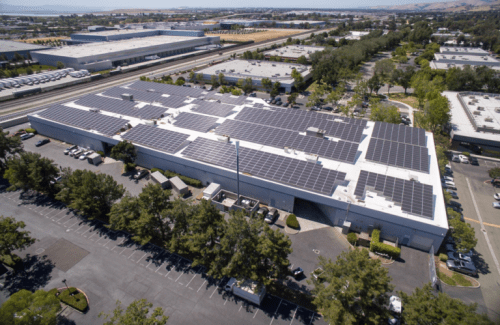
Splitting up with split incentives
How green leases remove barriers to energy efficiency in commercial buildings.
Sonic Manufacturing Technologies’ energy bill fell from $35,000 per month to $0 per month. That’s because the owner of their 82,000-square-foot building invested $3.5 million to upgrade the facility to zero net energy(ZNE). A combination of solar PV and energy efficiency retrofits resulted in a building that now generates as much energy as it uses.
Why would the building owner invest in building upgrades when cost savings from the lower energy bills accrue to the tenant?
Overcoming the split incentive barrier
While the ZNE retrofits made the building more valuable to the owner, that’s only part of the story. A green lease was the key. This arrangement allows a building owner and tenant to share the benefits and costs of green upgrades.
Ordinarily in commercial tenant situations, the incentives to retrofit for energy efficiency and renewable energy are split between the building owners and the tenants. Building owners do not usually pay the energy bill, so they will not benefit if they pay for energy efficiency upgrades. Conversely, tenants usually do pay the energy bill, but they do not own the building – so they are hesitant to invest in someone else’s building. A green lease helps overcome this impasse.
When the energy efficiency and renewable energy upgrades facilitated by a green lease are in place, the building owner can capitalize the cost of energy as a higher rent payment instead of having the tenant pay a monthly energy bill to the utility. If the tenant, in turn, saves more on their energy bill than the additional rent, then the green lease will provide incentives to both parties.
Developing a green lease
A good time to establish a green lease is when entering into a new lease or renewing a lease. When developing a green lease, these are the first steps to take:
- Benchmarking: Gather 12 months of energy data for the building
- Goal setting: Set an energy budget for the tenant with a not-to-exceed goal
Many green leases establish a financial penalty that kicks in if the tenant’s energy usage exceeds a certain threshold. While energy efficiency measures like HVAC and lighting controls help keep energy bills down, having a financial penalty for exceeding the baseline ensures that the tenant will continue to be vigilant about energy conservation.
Off-the-shelf green lease languageis available to inform the lease negotiation between building owner and tenant. This language should be customized for each situation, preferably with an attorney who has experience with green leases. For more guidance about structuring a green lease, visit the Rocky Mountain Institute’s Best Practices for Leasing Net-Zero Energy Buildings.
The Peninsula Advanced Energy Community (PAEC) Initiative isstudying best practices for green leasesand will issue a report on the findings. The report will suggest lease language best practices based on research into existing green leases, as well as input from practitioners such as attorneys, property owners, and building managers. It will also include information on the financial incentives that can support the transition to energy efficiency and renewable energy at leased space sites.
Implementing a green lease
Once a green lease agreement has been crafted, these steps can be taken:
- Conduct recommissioning – diagnostic testing to ensure that electrical and mechanical systems are working as intended and working together
- Implement solar PV and energy efficiency improvements
As Sonic Manufacturing Technologies found, the key to ZNE lies in doing energy efficiency retrofits first. Then, the facility’s new energy needs can be taken into account when ensuring that the available amount of rooftop and parking lot space is adequate for the amount of solar PV needed for the facility.
Building owners often apply green leases to offices, but they can also be used for manufacturing facilities. Even light manufacturing plants consume a large amount of energy per square foot relative to other types of businesses.
Benefits of a green lease
In a time when a majority of businesses rent their space, the green lease offers a useful tool for overcoming the split incentive barrier, adding value for both parties. The building owner gets a more valuable building with increased rent, and the tenant gets lower costs.
By establishing guidelines for the tenant and the building owner, the green lease also helps forge a better relationship between the parties. The green lease can help attract new tenants or encourage loyalty in an existing tenant – one who appreciates that the building owner invested in the well-being of their employees and the environment. These strengthened relationships will help build the Advanced Energy Communitieswe need for a clean energy future.
PAEC is a groundbreaking initiative to streamline policies and showcase projects that facilitate local renewables and other advanced energy solutions like energy efficiency, energy storage, and EV charging infrastructure. PAEC will create pathways to cost-effective clean local energy and community resilience throughout San Mateo County, the City of Palo Alto, and beyond. PAEC is a collaboration between the Clean Coalition, the California Energy Commission, Pacific Gas and Electric, and an array of municipalities, emergency response jurisdictions, schools and universities, and corporate entities. For more information, please visitclean-coalition.org/PAEC.
Image: Sonic Manufacturing Technologies. Source: Mynt Systems

